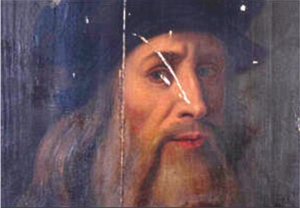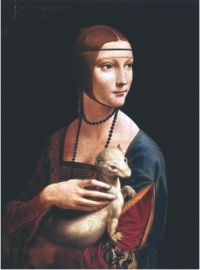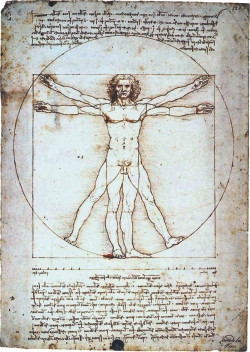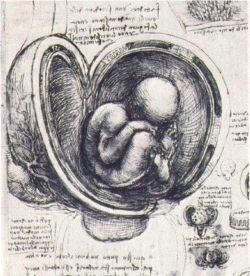| Home - Back Issues - The Team - Contact Us |
 |
| Volume 10 |Issue 43 | November 18, 2011 | |
|
|
Straight Talk Meeting Leonardo Again NADIA KABIR BARB
My first brush with Leonardo Da Vinci was at the tender age of eight. My family and I were on holiday in Paris and as one would expect a trip to the Louvre Museum was a must. So one sunny afternoon, when I would rather be anywhere else, I found myself standing face to face with one of the most famous women and paintings of all time – The Mona Lisa. I watched the other people around me staring intently and making appreciative noises and exclaiming at the sheer brilliance of this piece of work. I tilted my head this way and that way, walked from one side to the other trying to understand what all the hype was about. But no matter how hard I tried, all I could see at the time was a fairly unattractive woman with no eyebrows gazing out, the hint of a smile hovering on her lips. I recall being rather underwhelmed and really not particularly impressed. Maybe it was this initial opinion which had quite a lasting effect on me and stayed with me till early adulthood. I just never made friends with Leonardo or his works. I am certain that art connoisseurs and critics across the world would have frowned upon my youthful lack of enthusiasm for such a celebrated and talented artist.
However, over the years, I admit that I did come to appreciate a different aspect of Leonardo Da Vinci and that was his insatiable curiosity of the world around him and his desire to understand it. He was considered to be the quintessential Renaissance man with his thirst for knowledge spilling from the world of art into that of science, maths, engineering, architecture, anatomy, cartography, philosophy and writing. What I do find fascinating about Leonardo is that he was a visionary and forward thinker far ahead of his time. For example, his desire to depict an accurate image of the human body culminated in him being allowed to dissect human corpses at the Hospital of Santa Maria Nuova in Florence and later at hospitals in Milan and Rome. His detailed sketches of the human skeleton and musculature, many of which are still intact, are phenomenal. He is also known for making one of the first scientific drawings of a foetus in the womb. He also had a vast number of inventions that he worked on during his lifetime and of which he left detailed accounts in his journals. They include musical instruments, hydraulic pumps, reversible crank mechanisms, finned mortar shells, a steam cannon, a light hang glider and even a contraption resembling a type of helicopter. There must be a bit of a contrarian within me as I always found it strange that the man who is considered one of the greatest artists of all time was not a particularly prolific artist and one who was prone to leaving his work unfinished. In fact it is thought that only fifteen of his paintings are in existence. So when an exhibition dedicated to Leonardo Da Vinci named 'Painter at the Court of Milan' opened in the National Gallery in London, I felt it was time to see whether the legendary artist could finally win me over.
This was the first time that so many of his works had been brought together from all parts of the world to be displayed under one roof. All the paintings on display are ones that Leonardo embarked upon during his stay in Milan under the patronage of the then ruler Ludovico Maria Sforza. To my dismay, advance tickets were more or less sold out for the next couple of months. But as they say, when one door closes another one opens and my brother-in-law called me to ask if we would like to go to the exhibition with him. Needless to say, I jumped at the opportunity! We arrived at the gallery at the given time on our ticket and I was shocked to see that the queue for the limited number of five hundred tickets sold at the door snaked its way right around the building. The organisers had taken the view that only 180 people (including advance ticket holders) were going to be allowed entry every hour into the exhibition to avoid overcrowding and to allow people to enjoy the overall experience. We collected our hand guides and audio guides at the entrance and walked into a dimly lit gallery with a scattering of art work adorning the walls. The individual rooms were packed but due to excellent organisation on the part of the gallery, everyone managed to view each painting without being jostled. I took my time looking at the sketches and paintings, listening to the audio guide and trying to absorb the visual feast in front of me. Not only were there paintings by Leonardo but also those of his most famous students, Giovanni Antonio Boltraffio, Ambrogio de Pedris and others. What I did observe is that there is an obvious intelligence to Leonardo's work that, aged eight, was unsurprisingly lost on me. His attention to detail and desire to perfect his craft comes across in each of the rare artworks on display. Compared to his paintings, the ones on display by his pupils felt a little bit lacking in some way or another. There was no expression in the eyes or the models appeared somewhat two dimensional. I am no art connoisseur but in my humble opinion you could tell who the master was and who was the student. I was able to see the painting of 'The Musician', 'The Lady with an Ermine', 'The Virgin of the Rocks' (both versions — one housed in the National Gallery and the other on loan from the Louvre), 'The Madonna Litta' and so many other paintings and sketches without having to travel the globe. What was also fascinating was that there was a full scale copy of the famous mural 'The Last Supper' on display. It is possible that Dan Brown and his bestselling novel, The Da Vinci Code, may have generated a revival of interest and curiosity in some of Da Vinci's work especially 'The Last Supper'. I have to admit my curiosity had been piqued and I was thrilled at being able to see the painting, albeit a copy of the original. The original which hangs in the monastery of Santa Maria delle Grazie in Milan, is said to have deteriorated substantially due to Leonardo Da Vinci's invention of a new technique used for the mural that proved to be unstable. My view of Leonardo Da Vinci has taken a dramatic turn and I fully accept and agree with all the millions of people who might be inclined to say 'told you so' that he is truly a master and a genius. I have only one more comment to make here and that is having seen the exquisite painting of 'The Lady with an Ermine,' which depicts Cecila Gallerani, mistress of Ludovico Sforza, the Mona Lisa may have to step down and take second place!
Copyright
(R) thedailystar.net 2011 |



